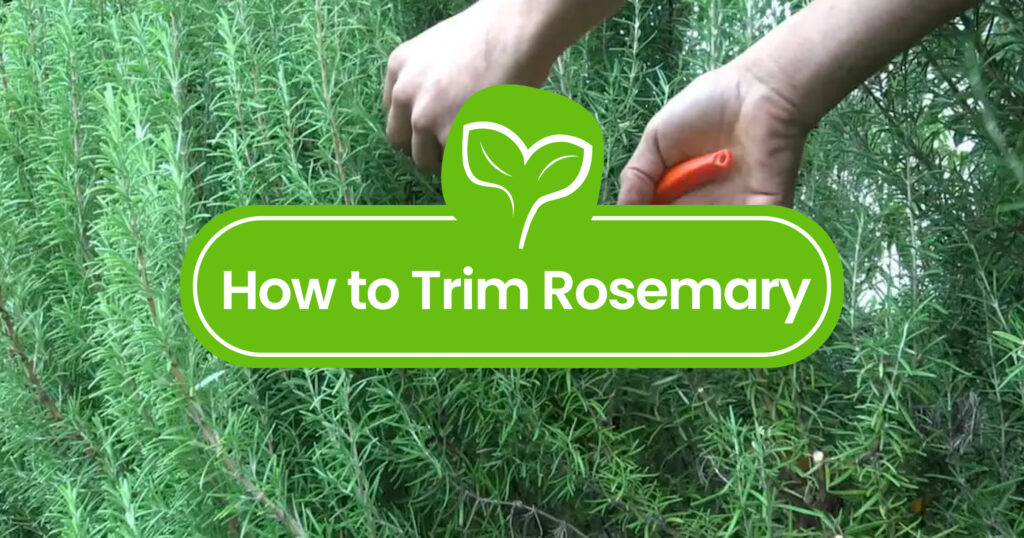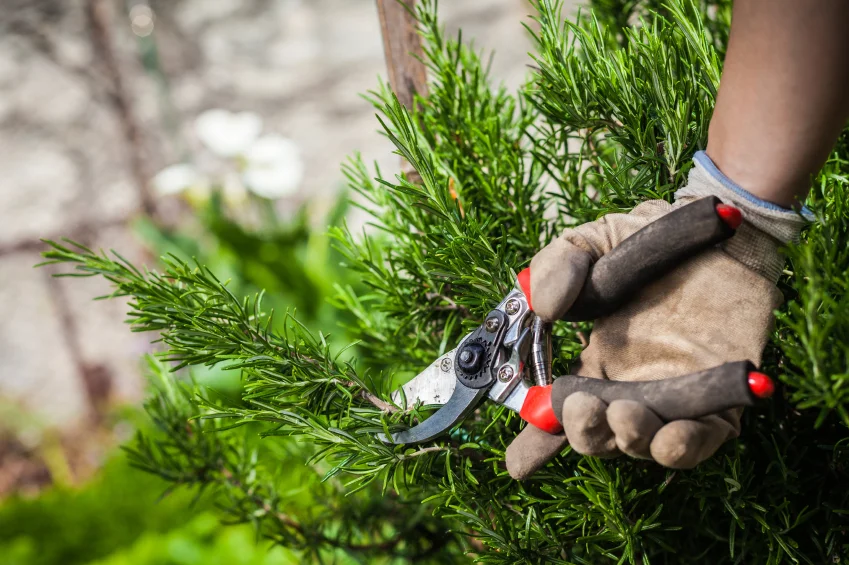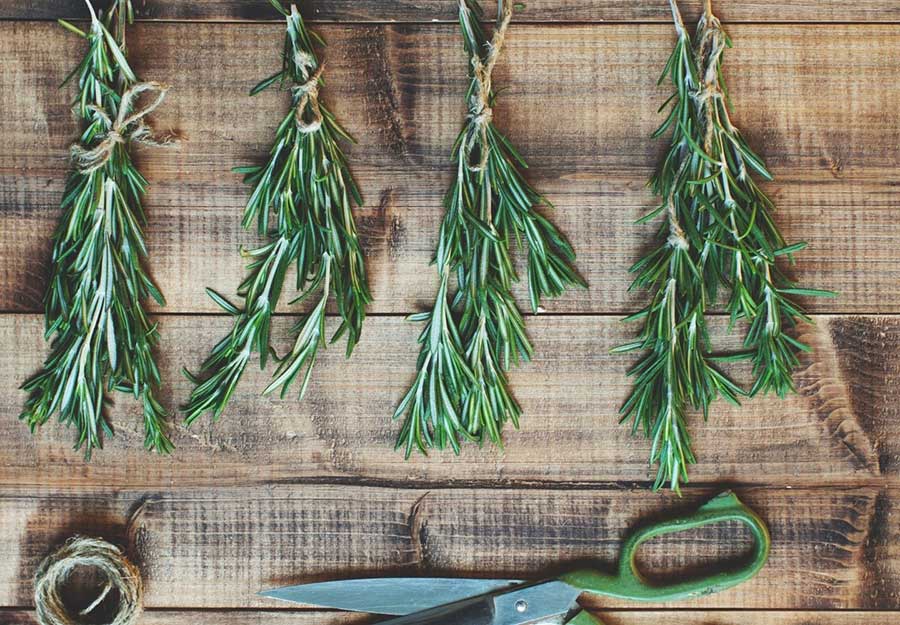
Rosemary is a brilliant addition to any indoor and outdoor herb garden. The aromatic evergreen herb rewards you with flavorful leaves that enhance the flavor of any dish.
Pruning plays a crucial role in the health and flavor of rosemary. In this article, we provide you with a step-by-step guide on pruning rosemary. And, of course, explore the benefits pruning has on the herb.
About Rosemary and its pruning basics
Want to understand the pruning process and its benefits before you start pruning your rosemary?
Pruning means the selective removal of branches, leaves, and other plant parts – the practice is performed for many reasons. Trimming back your rosemary plants encourages new growth, promotes their overall health, and enhances desirable characteristics such as aroma and flavor. It is also a simple way to maintain the desired shape and size of the herb.
You’ll need a pair of pruning shears to get started. And hand pruners come in handy for thicker rosemary branches.
How to trim rosemary step-by-step
The optimal time to prune rosemary is early spring before the new growth period begins. Moderate pruning is generally needed once or twice a year. However, you can give your plant a light trim when it gets leggy or overgrown. Now the question is, how exactly do you prune Rosemary?
- Sanitize your tools to ensure you’re working with clean equipment. You might also have to sharpen your pruning shears if they’re dull.
- Identify any dead or damaged parts. Signs to look out for are yellowing or browning parts, broken branches, and withered flowers. Remove them by cutting them off from below the damaged part.
- Pinch off the tops of the stems to encourage new growth. Doing so helps to create a bushier plant.
- Thin out overgrown areas of the plant – this promotes air circulation.
- Trim off around ⅓ of the plant. Make cuts where the branch meets the main stem or just above the nodes. You can identify nodes easily – they’re small buds on the stems where a set of leaves grow.
- Go back and selectively remove any branches to achieve the shape you desire.
Shaping and styling

Shape maintenance is another benefit of rosemary pruning. It doesn’t just make the plant aesthetically pleasing -it also promotes airflow and keeps the herb accessible. There are a few common shapes for rosemary bushes.
- Mounding shape – A bush with rounded edges and a tall center is achieved by pruning the outer branches.
- Compacted shape – Trim back new growth regularly to encourage branching and maintain a compact form.
- Rounded shape – To achieve a round shape, trim all around the rosemary bush evenly.
Rejuvenating older plants tends to call for more severe prunings. Alternatively, you can rejuvenate older and overgrown plants over several seasons.
Additional tips
Successful rosemary pruning doesn’t require much. Follow the correct pruning methods and safety procedures, and your rosemary will thrive.
- It’s easier to avoid mistakes than to deal with the aftermath. So, don’t prune too much of the plant at once – one-third is enough!
- Use clean and sharp tools to get clean cuts instead of jagged ones.
- And don’t start your pruning project during frosty weather.
- Proper aftercare for pruned rosemary is as crucial as following correct pruning techniques.
- Keep the soil of your rosemary moist by watering it regularly.
- A balanced fertilizer helps to nourish a freshly trimmed plant.
- And don’t forget sunlight – rosemary thrives in full sun, so allow it to get at least 6 hours daily!
How to use harvested rosemary?

Most home gardeners grow rosemary to harvest it. The best time for harvest is just before the herb blooms. That’s when the herb has the most intense flavor and aroma. The harvesting process is simple. You’ll want to cut off healthy-looking stems, wash them under cool water and pat them dry.
Use fresh rosemary straight away to season any savory dish. Harvested a larger amount of the herb that you won’t use up in a dinner or two?
Drying it helps to preserve it! Choose a cool area away from the sun and hang your branches upside down. Once your herb has dried, remove the leaves from the stems and store them in airtight containers or bags. You’ll have dried rosemary for months!
To sum it up
Growing rosemary is a simple job that rewards you with a flavorful harvest of the herb that has countless culinary uses. Want to promote healthy growth and maximize the flavor of your rosemary? It’s essential to prune it and follow proper guidelines when doing so.
Follow our rosemary pruning guide and apply the tips in this article the next time you trim your rosemary plant.
Frequently Asked Questions
Start with cutting off dead or damaged branches. Next, trim the tips of the branches cutting above the leaf nodes – remove around 1/3 of the bush. Don’t remove too much foliage at a time, and avoid cutting into old wood.
Should you prune rosemary?
While pruning isn’t necessary for growing rosemary, it has many benefits. Pruning is essential for achieving a highly productive and bushy rosemary plant.
Does rosemary go dormant?
Rosemary is an evergreen plant, meaning its leaves remain green all year around. However, it does go dormant during the winter and stops growth until early spring.
When to prune rosemary?
Rosemary can be pruned anytime in spring and summer. The last trim should be 4-6 weeks before the first frost.
Do you cut down on rosemary for winter?
Stop trimming your rosemary around 4-6 weeks before the first frost. That gives the herb enough time to harden off, protecting it from any damage caused by cold weather. You don’t need to cut your rosemary down for winter.
What happens if you don’t prune rosemary?
Pruning isn’t essential for rosemary, and your herb won’t die if you decide against pruning. However, it might become leggy and less productive over time.

